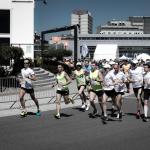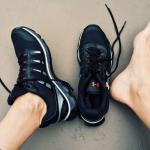Running is a great form of exercise- it requires minimal equipment and can be done at anytime and anywhere. It also boasts a range of health-boosting benefits, including improved cardiovascular fitness, improved blood sugar control, healthy bones, and, more recently been found to be the only form of exercise that can actually strengthen the intervertebrael discs of the back!
Unfortunately, it can also lead to a number of musculoskeletal injuries. In this blog post we will discuss some of the most important factors in running technique that may help decrease injury risk, and also improve performance.
Cadence (number of steps per minute)
Why is it important?
Every time the foot fits the ground, ground reaction forces must be absorbed by the body. The longer your foot is in contact with the ground, the higher the ground reaction force. Depending on your running speed, you may have up to 3-4 x your body weight being absorbed by your lower limb each foot strike. As you can imagine, this is thousands and thousands of pounds during a standard run!
Those with a cadence of <160/min are at a far higher risk of overuse and knee injuries than those with a cadence of 170. Further reduced risk if you’re sitting around the 180/min mark!
How do I improve?
- Aim to increase your cadence by no more than 5-10% at a time- “faster steps” can be a good cue for many people. Some free running apps such as runkeeper will record this for you.
- Explosive speedwork - incorporate faster runs and build power through explosive strength work- Plyometric work is very useful.
Ankle Mobility
Why is it important?
Imagine trying to run in a ski-boot. Tough work? Yes- because ankle mobility is limited. Good ankle mobility is important to prevent overload of other joints and allow proper mechanics of the lower limb
How do I improve?
- Ankle mobility can be limited by the joint itself, or the soft tissues that surround the joint- particularly the calf muscles. Incorporate the knee to wall stretch or “heel off step” stretch into your routine.
Hip- knee control
Why is it important?
Strength and control of the gluteal muscles that stabilise the pelvis are crucial for optimal running biomechanics. Control of these muscles will limit the amount of dynamic knee valgus or “knock knees” throughout your run, which can lead to knee pain.
How do I improve?
- Don’t neglect strength exercises, particularly single leg stability and hip stability
Stride length
Why is it important?
Overstriding (landing with your foot in front of your body) results in excessive breaking forces and force transferred through your limb. This increases your risk of hamstring injuries, Achilles tendon injuries, knee injuries and of course the dreaded shin splints!
How do I improve?
- Improve your cadence!
- A large heel profile in your shoe may also be contributing to overstriding.
Other common causes of running injury include;
- Worn out or poorly fitted trainers. Update regularly (every 600-700miles) and get fitted at a specialist running store.
- Neglecting to strength train and maintain flexibility.
- Increasing training load too quickly (mileage, speed, sudden increase in hill running). Try not to overload any given week by >10%
Also important to remember, is that there is a wide range of normal- most people are never going to achieve “perfect” running technique. Trying to change too much at once may actually lead to injury, so if in doubt make an appointment to see your physiotherapist.
Our Barnes Clinic
Our clinic is located in Barnes, South-West London and is easily accessible by public transport.
For more information including parking and other practicalities see our Barnes clinic page
Book an Appointment
Booking an appointment with one of our therapists is quick and easy. There is no long waiting time and you don’t need a referral from your GP.









